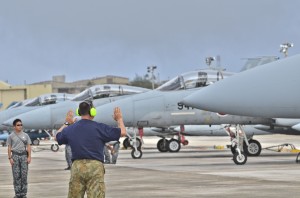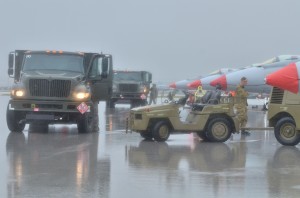2014-03-05 During a visit to Joint Base Pearl Harbor-Hickam, Hawaii, at the end of February 2014, Second Line of Defense had a chance to talk with Col. Mickey Addison, Director of Installations and Mission Support and the PACAF command engineer (A7), and Mr. James T. Silva, Deputy Director, Logistics (A4D), about the evolving PACAF approach to logistics and sustainment in the vast area of operations.
SLD: How important is an ability to provide forward based logistics or traditional logistics, whatever you want to call it, as part of a credible force in the Pacific?
Col. Addison: It is crucial.
General Hap Arnold, in preparing the after action report for World War II, highlighted the centrality of logistics and combat support for Air Force operations. He wrote, “Modern war is a war for air bases, the bulldozer must accompany the plane,” and of course the fuel truck and warehouse and the ships and all the specifics that go with supporting a forward deployed air force.
The key terrain during and prior to World War II and the key terrain during the Vietnam and Korea conflicts and all the other conflicts we’ve had in the Pacific is still the same key terrain today. And we have the same allies, many of the same partners, the same friends, and the same places that are important to us.
The key areas are still important for different reasons, but they’re still key terrain to enable our strategy.
Logistics is the linchpin of sustained operations in the Pacific because of the distances involved, and the USAF is very good at logistics
There’s a lot more involved operationally than just showing up at an air base and starting to fly.
SLD: With shaping a distributed operational strategy for Pacific Defense, which is really the 21st century approach, the logistics challenge is even more important, for we have to work the basing issue quite differently for operational and political reasons.
Jim Silva: It is. And General Carlisle focuses on places not bases.
Our engagement strategy is based on our ability to exercise and work with our partners and allies, all the way down to the action officer level.
So if something does come up, be it a humanitarian crisis, like typhoon Haiyan that just hit the Philippines or an actual military contingency, we have relationships in place; we’ve been to these places and we can go and operate there much more effectively.

SLD: But how does the notion of an expeditionary Air Force implementing a distributed operational approach in the Pacific dovetail with shaping places not bases?
Col. Addison: A key factor is the engagement approach Jim was talking about.
For example, when we supported the Philippines in the recent typhoon Haiyan disaster, we went to Tacloban. We had familiarity with the country, and had an existing working relationship with the Philippine Armed Forces so we could rapidly and collaboratively support the Philippine Air Force (PAF)_to shape an infrastructure to bring in relief assets.
Our engineers had been to Tacloban so we knew the airfield; we had worked with the Philippine engineers so we knew what they needed and how they operate. We had worked with the Marines and who set up initially, and then transitioned when our operators showed up to help run the airlift operation in Manila that ended up being a hub for the operation.
The other part of it is, go back to World War II and look at B-24 operations out of Hickam. Squadrons were based out of Oahu in 1942 that hopscotched across the Pacific to their staging bases and launched out to strike enemy targets across the Pacific.
We don’t have to leapfrog around from atoll to atoll now because we have aerial refueling and long-range aircraft they didn’t have back in World War II, but the idea is the same.
There’s only so much land out in a big ocean, so our ability to rapidly begin to operate at an austere location and then sustain those operations is very important to our strategy in the Pacific.
The key terrain, that was key terrain in 1935, is still key terrain in 2014. Those were places that we’re going to need to go and set-up quickly and operate in almost any kind of operations you can imagine.
There is a clear need for flex bases in the Pacific. We also need continuous linkages to the forward places, back and forth to replenish.
SLD: The template is clear but to meet 21st century political and operational realities you are reshaping the approach to some extent?

Col. Addison: We are.
We are constantly working to build and maintain relationships in the Pacific to enable us to help maintain the peace, and work together to rapidly recover from natural disasters.
SLD: With the new IT systems and RFID tags it is possible to do a better job of knowing what is where so if you have an aggregated joint facility, one can better disaggregate what the USAF might want out of that facility?
Jim Silva: The system is not perfect. There is always the human factor, of the person who moves the part but does not record its movement.
Nevertheless, we are aggregating materiel and tracking it to specific locations.
For example, with regard to prepositioning ships, those ships may be carrying munitions for the USMC, for the USN, and for the USAF. All of this will be on the same ship and each of the services know exactly where it is.
In addition, the supply chains are linked together by DOD systems and policy. The inventory systems are all managed through the DOD. So we don’t have different tracking numbers for all our parts.
Once you reach one step beyond the DOD level, and jump into service-specific tracking, we still keep those same stock and part numbers that are resident in the DOD system, so we can draw linkages back to where the items are located.
SLD: So you have better tools to try to manage the diversity of logistics parts and key elements distributed over the Pacific?
Jim Silva We do.
This is why as well that our exercise and engagement approach is so important specifically in the sustainability arena. We go to the facilities; we exercise; we test the parts availability and usability and can gain greater confidence in the sustainment capabilities from the stocks distributed throughout the Pacific.
SLD: When one focuses on exercises, one usually looks at the forces operating together. But you are emphasizing that that is simply the tip of the iceberg. In reality, the sustainment enterprise is being built and exercised through your exercise and engagement approach?
Col. Addison: It is. Take Australia as an example. We have a great relationship with the Royal Australian Air Force (RAAF). Like any relationship, the best way to deepen it is to spend time together.
And I think that all the things we do at our level, either with logistics or combat support or operations or whatever we’re doing, any time we operate with the Aussies anywhere in the world, we build trust; we build a relationship with each other.
We learn more about each other, how they operate and they learn how we operate.
And so when it comes time to do something for real and not as part of an exercise, the transition happens a lot more smoothly.
SLD: Another change which I have heard earlier discussions about is what one might call shaping a logistics enterprise approach so one can do a better job of leveraging commonality with new aircraft between allies and the US or in our ability to move major parts in the system up against the priority operation. Could you discuss this?
Col. Addison: Let me take the second case. The hard part is landing jets loaded with bombs, gas, food, fuel and keeping that force supplied so they can do something besides just being a static display. We work hard at truly building a linkage to the rest of the network.
Jim Silva: Let me take the first case and discuss from the standpoint of our relationship with the Aussies with regard to C-17s. If one of our C-17’s breaks in Australia, they have C-17 parts.
We don’t even have to negotiate anything because there is pre-set agreement that we just trade parts.
All of their parts are certified and can be used on any C-17 aircraft around the world.
So we can go take an Aussie part and put it on an Air Force airplane, and vice versa; they can even use a U.S. Air Force part if one of their jets lands here in Hickam. The system is managed across the enterprise.
SLD: Another aspect of a 21st century approach is building an enterprise network to support the expeditionary force, rather than stocking up inventory at fixed bases and defining maintenance as the organic capacity for the base to support “its” aircraft.
Could you discuss this evolving approach.
Jim Silva: There’s an Air Force-level initiative called Repair Network Integration, where we changed the way we manage many of our repair assets.
For example, taking our old engines, let me date myself, in the early 80’s, every unit had an engine shop, a full-blown engine shop.
We picked up a whole jet engine intermediate maintenance crew when we deployed, moved it forward and operated. We don’t do that anymore, we literally say an engine is just as much a repair part as any small widget you need to repair an aircraft.
So for example, during air operations in Operation Iraqi Freedom, we set up a European hub that did engine repairs. Well we found out there were some flaws in their maintenance practices and as a result we temporarily shut that engine hub down.
So we would presumably not be able to support air operations anymore. Now we have built an enterprise network so we can ship an engine from Misawa Air Base, Japan, that should be destined for the Pacific but we find there’s a higher priority somewhere else in the enterprise. We simply shift the engine destination to the highest need across the enterprise.
So if I take out a particular node anywhere, of my engine capability in the Pacific, West Coast comes up and says, I’ve got an engine, I’ll ship it to you, and it comes by another source.

